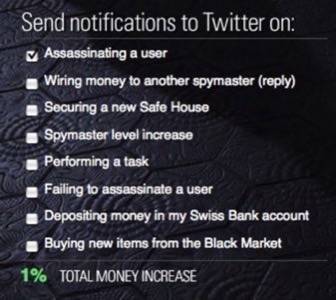Many web apps claim virality; very few actually find it.

In a new series exploring the anatomy of truly viral apps, our first specimen is Spymaster, the Twitter- and Facebook-based social game that exploded with tens of thousands of users within hours of the creators throwing up a simple page and absolutely no media coverage. From creating addiction to managing site traffic, read on to learn how they did it and what they’re doing next.
What kinds of outreach did you do during the early days?
Chris Abad, CEO of Irata Labs, the company that developed Spymaster, revealed that their early promotions were extremely minimal
“We threw up a splash page, but didn’t talk about it too much. Really, our first ‘outreach effort’ was sending out some invites to a few of our friends, and things ended up taking off on our own from there.”
To give some context, Abad told me that I personally had signed up for the game within a couple hours of its launch; by that point, I had already seen a few tweets and a DM about the site and was completely intrigued.

In your opinion or experience, was it media coverage, influencer buzz, or both that contributed to a large group of users signing up?
“Especially on Twitter,” said Abad, “everyone is really big on ‘influencer buzz,’ but I don’t feel that was a very big factor with Spymaster. There really wasn’t as much as we were hoping for in that area.”
Even without top Twitter users getting into the app, however, Abad said other factors were at work to create the viral effect, the first being media attention.
“The media buzz (there was a lot in the first few weeks of Spymaster)… provided the fuel. And some of the intentional viral mechanics built into Spymaster, things such as public activity updates, DM invites, common hashtags, etc., were really the vehicles through which the word of Spymaster spread.”
Some of those mechanisms were not too appreciated by users; and as the tide of Spymaster-themed, auto-generated tweets swelled from users who were given in-game incentives to keep on tweeting, irritation became a public outcry and threats of unfollowing circulated.
Still, back-and-forth banter and “assassination” plots were the guilty pleasure of many an early adopter and even a few tech bloggers (guilty!).

What about Spymaster do you think made people want to sign up and start using the app?
Abad said that design, fun, and a certain addictive factor made Spymaster irresistable to early users.
“People wanted to try it because it was an interesting, well-executed game. For a web-based, social game, the creative around Spymaster was phenomenal. [Read our interview with Spymaster designer Eston Bond for more background on designing web apps.] Also, as people played it, they found the gameplay to be interesting (even addicting at times).
In short, it was something fun to do.”
Also, he noted that there was a particular novelty to Spymaster. It was the first massively scaled Twitter-based game, and within a day or two of its launch, he said, “It quickly got to the point where it felt like everybody was doing it, and a lot of people would check us out just to see what all the buzz was about.”
What did you learn about handling massive amounts of traffic? In your case, were there unexpected traffic spikes?
Spymaster lead architect Ben Myles said, “We had some huge traffic in the early days of launch from all the press we garnered. It wasn’t completely unexpected, but it was also a
week of non-stop optimizations and maintenance.”
So, what did the Spymaster technical team do to counterbalance a massive wave of user traffic?
“We did some obvious and simple things,” said Myles, “like moving the majority of our static assets to [Amazon] S3. When we first launched Spymaster our data store was primarily MySQL. We started hitting some concurrency issues with MySQL, and over the period of a few weeks we moved most of our data into a key/value store (Tokyo Tyrant). The success we had with Tokyo Tyrant exceeded our expectations and our scaling since we made that shift has been relatively painless.”
What are your future plans for scaling, including internationally?
As most users have noticed, Spymaster has expanded over the past few months to include Facebook, MySpace, and iPhone apps in addition to the original Twitter game.
“We also proactively advertise, and have a growing user base in other English-speaking countries,” said Abad.
If you could pass on one piece of advice to the founders of the Next Big Social App on how to get a critical mass of users, what would you tell them?
“Experiment,” said Abad. “Try different things until you find something that ‘catches.'”
Most important to apps that aim for virality, he continued, is that the push for user adoption and ever-increasing traffic can never stop or slow. Especially when your app unexpectedly explodes out of its petri dish and takes over the lab, “That’s no time to let up on the gas.”
“Critical mass is often one of those things where you don’t know what it is until you’ve already passed it, so you push even harder.”
Abad also said “social” apps should be social by design. “This doesn’t mean throwing an inviter screen in there a few days before launch… Work the tools into that process that make it easy for your users to spread the word to their friends.”
Also, he said, “Your most passionate users are often your best marketers. Treat them well, and reward them for evangelizing your brand.”

Bonus round! What’s next for the Spymaster team?
“We do have some pretty exciting stuff we’re working on right now,” said Abad. “It’s still a little early to get too far into it, but we do hint at the new project here.” Our guess is as good as yours for the moment, but we’re guessing at a deep-sea adventure that, like Spymaster, will test our limits and exceed our expectations.
“More than anything,” Abad concluded, “Spymaster was about innovating in the social gaming space. It was about answering the question, ‘What can we do that’s unique and outside-the-box?’ We pushed a few boundaries with Spymaster, and had a lot of fun doing it. With our next project, we’re taking a lot of the ideas and lessons that came out of Spymaster and pushing that mentality even further.”
If the web 2.0 dictum “Once, you’re lucky; twice, you’re good” holds water, this next app will show whether Abad and his team have found a pathway to Internet virality or whether Spymaster was simply a lucky strike. But after dissecting this truly viral blockbuster of a game, aspiring startups might put less weight on luck and make a study of the Spymaster method.










